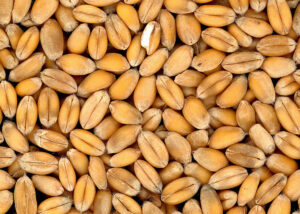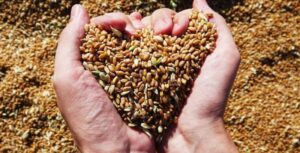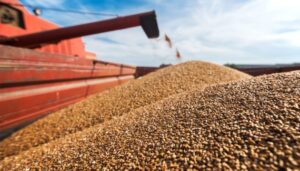
As of August 1, farmers harvested 15.47 million tons of early grains and legumes from 4 million 423.9 thousand hectares, which is 39% of the area sown with these crops, according to the Ministry of Economy.
Last year, as of August 2, 25.29 million tons of grain were harvested from 6 million 106.1 thousand hectares, which means that the current figures are 38.8% and 27.5% lower, respectively, and the average yield, which is 3.5 tons/ha, is 15.6% lower.
According to the Ministry of Economy, 11.36 million tons of wheat were harvested from 3 million 54.2 thousand hectares (last year – 19.44 million tons from 4 million 465.8 thousand hectares), barley – 3.57 million tons from 1 million 14.8 thousand hectares (4.82 million tons from 1 million 294.1 thousand hectares).
The average yield of these crops this year is 3.7 tons/ha and 3.5 tons/ha, respectively, which is 14.6% and 5.5% less than last year’s figures.
At the same time, this year’s pea harvest is already higher than last year’s – 0.49 million tons from 208,200 hectares compared to 0.45 million tons from 205,700 hectares, and the yield is 7.7% higher at 2.4 tons/hectare.
Other cereals and legumes were threshed on an area of 145,500 hectares, with a harvest of 50,400 tons.
It is noted that among the leaders are, in particular, the Odessa region with 0.09 million tons from 1 million 70.4 thousand hectares, the Kirovograd region with 1.93 million tons from 462.9 thousand hectares, and the Poltava region with 1.52 million tons from 344.7 thousand hectares.
Farmers in the Dnipropetrovsk and Kherson regions have begun threshing millet, harvesting 83 tons from an area of 1,200 hectares, the Ministry of Economy added.
According to its data, as of August 1, 1.76 million tons of rapeseed had already been harvested from an area of 781,900 hectares, while last year on August 2, 3.24 million tons were harvested from 1,195,500 hectares, and the average yield is 16.8% lower than last year’s on this date and amounts to 2.3 tons/hectare.
As reported, the National Bank of Ukraine, in its Inflation Report published on Friday night, lowered its forecast for this year’s grain harvest from 61.7 million tons to 57.9 million tons, and for oilseeds from 22 million tons to 21 million tons.
The NBU recalled that last year, the grain harvest in Ukraine fell to 56.2 million tons from 59.8 million tons in 2023, while oilseeds fell from 21.7 million tons to 20 million tons.

As of July 25, farmers harvested 10.347 million tons of early grains and legumes from an area of 3.236 million hectares, compared to 7.226 million tons from 2.355 million hectares a week earlier, according to the Ministry of Economy, Environment, and Agriculture.
The ministry noted that farmers have already harvested 29% of the area sown with grain and leguminous crops.
According to the Ministry of Economy, 7.088 million tons of wheat have been harvested in Ukraine so far (compared to 4.671 million tons a week earlier) from 2.178 million hectares (1.504 million hectares), barley 2.792 million tons (2.182 million tons) from an area of 838,700 hectares (660,600 hectares), peas – 412,400 tons (362,900 tons) from 190,900 hectares (170,800 hectares). Other cereals and legumes were harvested in the amount of 54.2 thousand tons from an area of 28.5 thousand hectares.
The leaders in grain and legume harvesting are the Odesa region, which harvested 2.5 million tons from 884,500 hectares, Kirovohrad – 1.53 million tons from 368,700 hectares, and Mykolaiv – 1.387 million tons from 577,300 hectares.
Rapeseed has been harvested at 1.04 million tons (614,100 tons) from 535,000 hectares (360,300 hectares).
As reported, as of July 26, 2024, Ukraine had harvested 22.324 million tons of new crops, including 19 million tons of grains and over 3 million tons of oilseeds. At the same time, 14.7 million tons of wheat were harvested from 3.5 thousand hectares, 3.8 million tons of barley from 1.02 thousand hectares, 416,300 tons of peas from 189,800 hectares, 3 million tons of rapeseed from 1,086 hectares, 0.3 thousand tons of soybeans from 0.2 thousand hectares, and 80 tons of millet from 50 hectares.

The production acreage in Ukraine in the 2025 season will be identical to last year’s, plus 270,000 hectares of demined land, said First Deputy Minister of Agrarian Policy and Food Taras Vysotsky.
“Overall, the production areas will be the same as last year. An additional 270,000 hectares have been demined. But in terms of our total sowing area of 20 million hectares, this is 1%. So, for basic crops, to which we will add sugar beets and vegetables, farmers will have 20 million hectares. This confirms that we are working in all possible areas,” he said at a meeting of the Trend&Hedge Club on Wednesday.
According to Vysotsky, the Ministry of Agrarian Policy and Food expects to harvest 21.2 million tons of wheat in 2025, compared to 22 million tons a year ago, which is 5% less. The ministry estimates wheat exports at 15-16 million tons.
According to him, the barley harvest will amount to approximately 4.5 million tons, which is 10% less than in 2024, with exports at 2.2-2.3 million tons.
The Ministry of Agrarian Policy does not expect any problems with buckwheat and promises that the domestic market will be supplied and the surplus exported.
The ministry is not yet ready to make final forecasts for grain corn, as the active growing season is still underway. However, departmental analysts adhere to a conservative forecast of 26 million tons, which is also at least 5% less than last season.
“We see grain at around 54.5-53.5 million tons.
This is plus/minus 5%,” Vysotsky emphasized.
He added that the rapeseed harvest in the 2025 season is expected to be 3 million tons, compared to 5.7 million tons in 2024, soybeans – 5.7 million tons, compared to 6.6 million tons, and sunflowers – 20 million tons.
Vysotsky noted that the greatest doubts about harvest volumes currently concern sunflower, as the crop is suffering from drought in the south of the country, and these regions may lose up to 6% of their harvest, which could lead to a reduction in the gross harvest to 15 million tons or less.
In total, the oilseed harvest in Ukraine in 2025 will amount to 20.5 million tons, the first deputy minister of agricultural policy concluded.

Nibulon, one of Ukraine’s largest grain market operators, has launched a new service – harvesting. The grain trader has already processed more than 5,000 hectares in the Odesa region, according to its press service.
According to the report, Nibulon uses Claas Lexion 7700 combines and its own fleet of trucks to carry out the work, which allows it to control the entire chain from the field to the elevator.
The harvesting service includes the delivery of equipment exactly on time, transparent pricing — a fixed rate per crop, booking without obligations, but with priority during the season.
The agricultural holding is now ready to scale up and sign further contracts with producers throughout Ukraine.
Nibulon LLC was established in 1991. Before the Russian military invasion, the grain trader had 27 transshipment terminals and complexes for receiving agricultural crops, a capacity for one-time storage of 2.25 million tons of agricultural products, a fleet of 83 vessels (including 23 tugboats), and owned the Mykolaiv Shipyard.
Before the war, Nibulon cultivated 82,000 hectares of land in 12 regions of Ukraine and exported agricultural products to more than 70 countries around the world. In 2021, the grain trader exported a record 5.64 million tons of agricultural products and delivered record volumes to foreign markets in August (0.7 million tons), in the fourth quarter (1.88 million tons), and in the second half of the year (3.71 million tons).
The grain trader is currently operating at 32% of its capacity, has created a special unit for demining agricultural land, and has been forced to move its central office from Mykolaiv to Kyiv.

As of July 7, Ukraine had exported 77,000 tons of grains and legumes since the start of the 2025/26 marketing year (July-June), according to the press service of the Ministry of Agrarian Policy and Food, citing data from the State Customs Service.
According to the report, as of July 5 last year, total shipments amounted to 1.131 million tons.
At the same time, in terms of crops, since the beginning of the current season, 25,000 tons of wheat (320,000 tons in 2024/25 MY) and 0 tons of barley (134,000 tons) were exported, while corn exports amounted to 51,000 tons (673,000 tons).
Total exports of Ukrainian flour since the beginning of the season as of July 7 are estimated at 0.8 thousand tons (in 2024/25 MY – 1.8 thousand tons), including wheat flour – 0.8 thousand tons (1.7 thousand tons).

In 2024, the elevators of the IMC agricultural holding shipped a record volume of grain – more than 1.1 million tons, in January-June 2025, they completed the shipment of the remaining crop of 2024 and carried out preparatory work for the reception of the new harvest, the press service of the agricultural holding reported on Facebook.
The agricultural holding noted that in recent years, several projects have been implemented at IMC elevators as part of the Smart Green Strategy, in particular in the use of green energy.
“Four of IMC’s elevators have already been equipped with solar panels, and installation is underway at two more facilities, which will cover the demand for electricity from green sources for office buildings and critical infrastructure of elevators. This also contributes to the energy independence of the elevators and the continuous production process despite possible interruptions in electricity supply due to Russian shelling of Ukraine’s energy system,” IMC said.
In addition, two of IMC’s elevators and three grain drying complexes have installed heat generators that run on sunflower pellets and grain waste, which allows replacing natural gas with biofuel for the grain drying process.
“This year’s scheduled repairs at IMC’s elevators are already at the completion stage. We are currently disinfecting the production facilities. IMC elevators are ready to accept the new winter wheat harvest,” emphasized Andriy Havrylenko, Deputy CEO of IMC for Grain Storage and Processing.
IMC Agro Holding is an integrated group of companies operating in Sumy, Poltava and Chernihiv regions (north and center of Ukraine) in the crop production, elevators and warehouses segments. The land bank is 116 thousand hectares, storage capacity is 554 thousand tons, with a harvest of 864 thousand tons in 2024.
IMC ended 2024 with a net profit of $54.54 million against a net loss of $21.03 million in 2023. Revenue increased by 52% to $211.29 million, gross profit quadrupled to $109.10 million, and normalized EBITDA increased 25 times to $86.11 million.